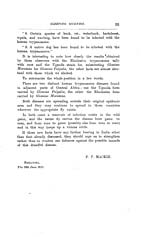Medicine - Disease > Sleeping sickness: a summary of the work done by the Sleeping Sickness Commission, 1908-1910
(42) Page 34
Download files
Individual page:
Thumbnail gallery: Grid view | List view

34 SLEEPING SICKNESS.
though laboratory experiments show that in theory other
tsetse flies can do so.
Finally, there remains the question of how the Rhodesian
trypanosome infects man. We have seen that this trypano-
some is distinct both from T. Gambiense and T. Brucei, and
we know that it is transmitted in areas free from Glossina
Palpalis but which are infested with the other common tsetse
fly Glossina Morsitans.
Stephens and Fantham sum up their observations (January
7th, 1912) as follows:-" It appears to us that the foregoing
evidence is strongly confirmatory of the view we put forward
in our original paper, namely, that we have two trypano-
somes producing Sleeping Sickness in man, namely, T. Gam-
biense and T. Rhodesiense and that the carrier of the latter
species is Glossina Morsitans."
In the Sleeping Sickness Bulletin which has just come to
hand (No. 37, Volume 4, published May 11th, 1912) the
report of the Luangwa (Rhodesia) Sleeping Sickness Commis-
sion is reviewed and the conclusions arrived at by Drs. Allan
Kinghorn and Warrington Yorke are so important that they will
be quoted in full.
" 1. The human trypanosome, in the Luangwa Valley, is trans-
mitted by Glossina Morsitans, Westw.
' 2. Approximately 5 per cent. (4.76) of the flies may be-
come permanently infected, and capable of transmitting the
virus.
" 3. The period which elapses between the infecting feed of
the flies and the date on which they become infective is
approximately fourteen days.
"4. An infected fly retains the power of transmitting the
disease during its life, and is infective at each meal.
" 5. Mechanical transmission does not occur if a period of
twenty-four hours has elapsed since the infecting meal.
" 6. Some evidence exists to show that in the interval between
the infecting feed and the date on which transmission becomes
possible the parasites found in the flies are non-infective.
" 7. Glossina Morsitans, in nature, has been found to transmit
the human trypanosome.
though laboratory experiments show that in theory other
tsetse flies can do so.
Finally, there remains the question of how the Rhodesian
trypanosome infects man. We have seen that this trypano-
some is distinct both from T. Gambiense and T. Brucei, and
we know that it is transmitted in areas free from Glossina
Palpalis but which are infested with the other common tsetse
fly Glossina Morsitans.
Stephens and Fantham sum up their observations (January
7th, 1912) as follows:-" It appears to us that the foregoing
evidence is strongly confirmatory of the view we put forward
in our original paper, namely, that we have two trypano-
somes producing Sleeping Sickness in man, namely, T. Gam-
biense and T. Rhodesiense and that the carrier of the latter
species is Glossina Morsitans."
In the Sleeping Sickness Bulletin which has just come to
hand (No. 37, Volume 4, published May 11th, 1912) the
report of the Luangwa (Rhodesia) Sleeping Sickness Commis-
sion is reviewed and the conclusions arrived at by Drs. Allan
Kinghorn and Warrington Yorke are so important that they will
be quoted in full.
" 1. The human trypanosome, in the Luangwa Valley, is trans-
mitted by Glossina Morsitans, Westw.
' 2. Approximately 5 per cent. (4.76) of the flies may be-
come permanently infected, and capable of transmitting the
virus.
" 3. The period which elapses between the infecting feed of
the flies and the date on which they become infective is
approximately fourteen days.
"4. An infected fly retains the power of transmitting the
disease during its life, and is infective at each meal.
" 5. Mechanical transmission does not occur if a period of
twenty-four hours has elapsed since the infecting meal.
" 6. Some evidence exists to show that in the interval between
the infecting feed and the date on which transmission becomes
possible the parasites found in the flies are non-infective.
" 7. Glossina Morsitans, in nature, has been found to transmit
the human trypanosome.
Set display mode to: Large image | Zoom image | Transcription
Images and transcriptions on this page, including medium image downloads, may be used under the Creative Commons Attribution 4.0 International Licence unless otherwise stated. ![]()
| India Papers > Medicine - Disease > Sleeping sickness: a summary of the work done by the Sleeping Sickness Commission, 1908-1910 > (42) Page 34 |
|---|
| Permanent URL | https://digital.nls.uk/74583986 |
|---|




